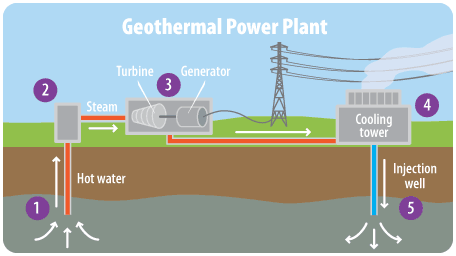Geothermal is one source of energy that has been explored, and utilized, in recent decades. It is heat which is stored beneath the earth – either in the soil, rocks, or the fluid portion of the mantle. It has been used primarily in heating our homes and producing electricity. The amount of geothermal energy within the crust leads to it having great potential for us.
Many around the world are using a geothermal heat pump system where pipes in a closed system filled with water, or another antifreeze type fluid, buried between 10-20 feet in the yard can move heat from the ground into the home during winter, and reverse the process during summer. If the house is insulated properly, the US EPA considers this method the most efficient one for heating and cooling your home.
Iceland is famous for their use of geothermal energy. Drilling pipes beneath the earth, they are using hot steam and water to heat buildings, provide hot water, grow vegetables in greenhouses, raise fish in aquaculture ponds, and spin turbines to produce electricity. The island is, of course, an active volcano – and that helps.
In 2011 over 40 countries had developed geothermal districts which were producing about 1% of the world’s electricity. The amount of electricity generated was equal to 104 nuclear power plants. In 2022 the United States had 3,965 geothermal plants in operation – the most in the world. The majority of these are in California, Nevada, Utah, and Hawaii.
In general, geothermal has less environmental impact than fossil fuels. If located near a good source, the cost is much lower to produce. However, there are two main problems. One, the cost of tapping into the system from locations far from the sources is high. Second, we could actually remove the dry or wet steam faster than the earth can replace them. Below are additional pros and cons.
| Advantages | Disadvantages |
| Very high efficiency | Scarcity of suitable sites |
| Moderate net energy at suitable sites | CO2 emissions |
| Lower CO2 emissions than fossil fuels | Moderate to high local air pollution |
| Low cost at favorable sites | Noise and odors (hydrogen sulfide gas) |
| Low land use and disturbance | High cost except at suitable sites |
There is one more source of energy to look at – hydrogen – and we will explore that one in the next article.
References
Geothermal Energy Fact Sheet. The Center for Sustainable Systems. University of Michigan. https://css.umich.edu/publications/factsheets/energy/geothermal-energy-factsheet.
Miller, G.T., Spoolman, S.E. 2011. Living in the Environment. Brooks/Cole Cengage Learning. Belmont CA. pp. 674.
- Tips for Bear Encounters this Fall - November 10, 2025
- Pensacola Bay Invasive Species Summer Survey 2025 - November 3, 2025
- Our Environment: Part 24 – Our Changing Climate - November 3, 2025

